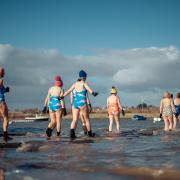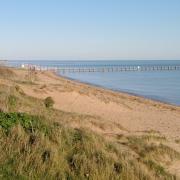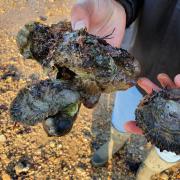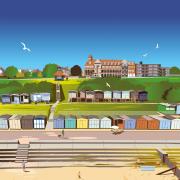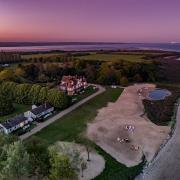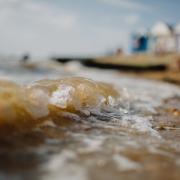A visit to the beaches of Walton on the Naze can reveal some unexpected finds and a glimpse into a 50-million-year history of our Essex coast, but how do you know what to look for?
The clay-rich geology of the Essex coast at Walton on the Naze is both a blessing and a curse. Coastal erosion crumbles away the land, but as it does so it uncovers many treasures from the past.
In fact, the Naze beach is littered with fossilised shark’s teeth dating back some 50 million years, and if you know what you are looking for, you can be pretty much guaranteed an historic find.

What to look for when hunting shark's teeth
Striatolamia striata sharks were once widespread across the world’s waters. They became extinct 5 million years ago, just as modern humans were starting to evolve. Once you know what you’re looking for, you’ll realise just how common a sight their teeth are in sediments and the beach at Walton on the Naze is covered with them.
These sharks could grow up to 3.5m (11ft 4in) long. Part of the sand shark family, they would have looked similar to their surviving relatives today: the rather fearsome-looking sand tiger shark.
Their Latin name, striatolamia, comes from the striations or grooves found on their teeth while the nickname ‘sand shark’ comes from their love of shoreline habitats and shallow waters.
Just like their modern-day relatives, striatolamia striata had a terrifying reproductive survival tactic. The pregnant female begins her pregnancy carrying around 50 embryos. But as the pups grow the larger, stronger offspring eat their smaller siblings, until only one pup remains, being born at a size of about 1m long.
The average shark has 50 000 teeth over the course of their lifetime, frequently shedding and regrowing them. Considering striatolamia striata inhabited the planet for more than 50 million years, between the Early Paleocene until the Late Miocene period, it should be no surprise that their teeth are such a common feature on the Naze.

Where to look: the lost Atlantis of Essex
The Naze is a wild and rapidly eroding headland just north of the seaside town of Walton on the Naze. It’s another reason Walton is one of my favourite Essex coast locations, giving visitors a dose of wilderness before they head back into town for the comforts of fish and chips and pier amusements.
Formed from 54-million-year old London clay, fossils are prolific on the Naze. The constant, relentless erosion on the headland means that more and more treasures are continually being revealed. Along with fossilised shark’s teeth as common as shells and pebbles, much rarer finds here include fossilised wood, shells and bird-bones.
But clay, so soluble in water, means the Naze is literally washing away. World War II pill boxes that have crashed dramatically onto the beach at the Naze attest to this, and the site of the original village of Walton today lies around nine miles out to sea.
Now something like the lost Atlantis of Essex, Walton was originally built as an inland farming settlement, illustrating the power of the sea and Britain’s ever-changing coastline.
Under immediate threat is the Hanoverian tower, more commonly known as the Naze tower, an eight-story, octagonal structure built on the Naze as a sea-mark in 1720.
Today housing an art gallery and open to visitors, this intriguing tower has had various uses over the years. If the pill boxes that have crashed into the sea are anything to judge by, the Naze tower might also meet its end on the beach in the next 50 years or so. The Naze has its own car park, or you can walk there from Walton town centre in 30 minutes.

How to find sharks teeth
When you get to the Naze, head down onto the beach to begin your search. With a bit of determination and following these few tips, you’ll have your very own shark’s tooth souvenir in a matter of minutes.
Firstly, find a patch of fine shingle, stones and shells to look in. There are tidal bands of these streaking the whole beach. I’d recommend that you head to a patch slightly closer to the land than the sea.
Next, squat or sit down and sift through the shingle with your fingers, concentrating on everything you see. You’re looking for a rich, dark brown colour, almost black when wet or damp, with a sharp, angular shape.
Most of the teeth you’ll find are small, perhaps only 2-3cm long. Stick to the same patch and persevere for a few minutes. If you want to be tactical, send off different family members to a few different areas.
Sometimes it only takes seconds, other days you have to try a little harder, but you will find one or perhaps several striatolamia striata shark’s teeth to take home.
You can also tell where the teeth would have sat in the shark’s mouth by their shape. The anterior teeth (near the front of the mouth) are generally longer, whilst the lateral teeth (nearer to the back) tend to be shorter and broader.
Happy shark tooth hunting!
For more coastal adventures from Elisabeth, see staring-at-the-sea.com
__________________
READ MORE
- Coastal walks in Essex: 9 of the best
- Wild Essex: 5 hotspots for nature lovers
- 9 of the best places in Essex for a picnic and a walk
- 16 of the best beer gardens in Essex
Follow Essex Life on Facebook, Twitter and Instagram
SUBSCRIBE to Essex Life magazine for history, food and drink, walks, the latest events and more
__________________










